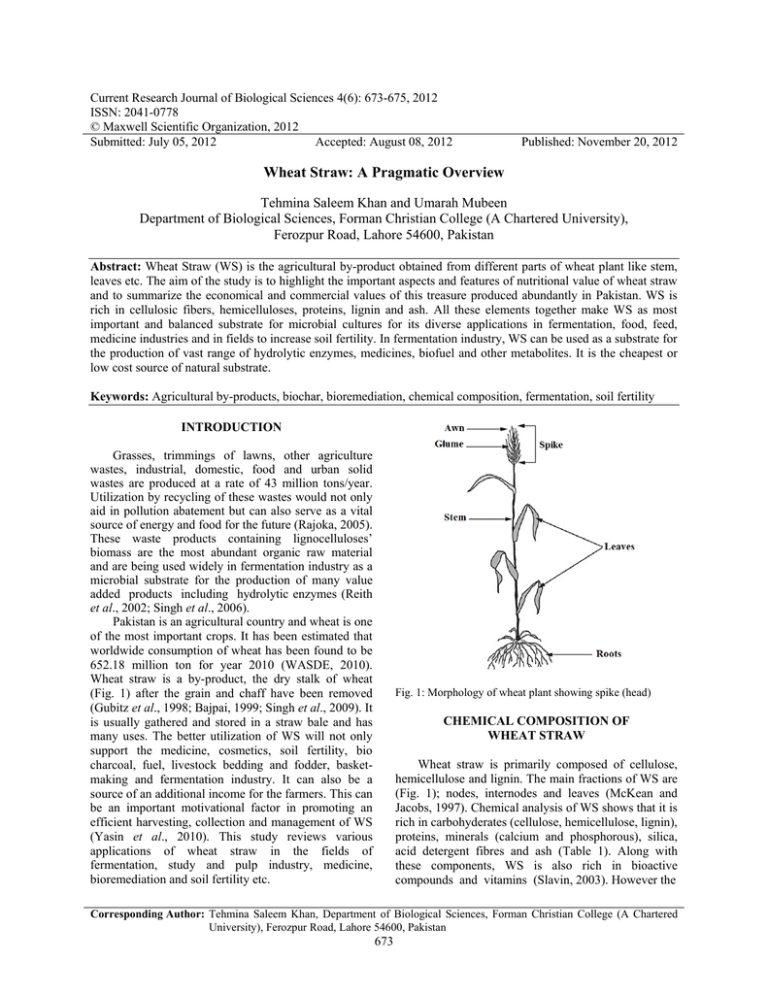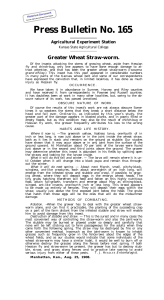Current Research Journal of Biological Sciences 4(6): 673-675, 2012 ISSN: 2041-0778
advertisement

Current Research Journal of Biological Sciences 4(6): 673-675, 2012 ISSN: 2041-0778 © Maxwell Scientific Organization, 2012 Submitted: July 05, 2012 Accepted: August 08, 2012 Published: November 20, 2012 Wheat Straw: A Pragmatic Overview Tehmina Saleem Khan and Umarah Mubeen Department of Biological Sciences, Forman Christian College (A Chartered University), Ferozpur Road, Lahore 54600, Pakistan Abstract: Wheat Straw (WS) is the agricultural by-product obtained from different parts of wheat plant like stem, leaves etc. The aim of the study is to highlight the important aspects and features of nutritional value of wheat straw and to summarize the economical and commercial values of this treasure produced abundantly in Pakistan. WS is rich in cellulosic fibers, hemicelluloses, proteins, lignin and ash. All these elements together make WS as most important and balanced substrate for microbial cultures for its diverse applications in fermentation, food, feed, medicine industries and in fields to increase soil fertility. In fermentation industry, WS can be used as a substrate for the production of vast range of hydrolytic enzymes, medicines, biofuel and other metabolites. It is the cheapest or low cost source of natural substrate. Keywords: Agricultural by-products, biochar, bioremediation, chemical composition, fermentation, soil fertility INTRODUCTION Grasses, trimmings of lawns, other agriculture wastes, industrial, domestic, food and urban solid wastes are produced at a rate of 43 million tons/year. Utilization by recycling of these wastes would not only aid in pollution abatement but can also serve as a vital source of energy and food for the future (Rajoka, 2005). These waste products containing lignocelluloses’ biomass are the most abundant organic raw material and are being used widely in fermentation industry as a microbial substrate for the production of many value added products including hydrolytic enzymes (Reith et al., 2002; Singh et al., 2006). Pakistan is an agricultural country and wheat is one of the most important crops. It has been estimated that worldwide consumption of wheat has been found to be 652.18 million ton for year 2010 (WASDE, 2010). Wheat straw is a by-product, the dry stalk of wheat (Fig. 1) after the grain and chaff have been removed (Gubitz et al., 1998; Bajpai, 1999; Singh et al., 2009). It is usually gathered and stored in a straw bale and has many uses. The better utilization of WS will not only support the medicine, cosmetics, soil fertility, bio charcoal, fuel, livestock bedding and fodder, basketmaking and fermentation industry. It can also be a source of an additional income for the farmers. This can be an important motivational factor in promoting an efficient harvesting, collection and management of WS (Yasin et al., 2010). This study reviews various applications of wheat straw in the fields of fermentation, study and pulp industry, medicine, bioremediation and soil fertility etc. Fig. 1: Morphology of wheat plant showing spike (head) CHEMICAL COMPOSITION OF WHEAT STRAW Wheat straw is primarily composed of cellulose, hemicellulose and lignin. The main fractions of WS are (Fig. 1); nodes, internodes and leaves (McKean and Jacobs, 1997). Chemical analysis of WS shows that it is rich in carbohyderates (cellulose, hemicellulose, lignin), proteins, minerals (calcium and phosphorous), silica, acid detergent fibres and ash (Table 1). Along with these components, WS is also rich in bioactive compounds and vitamins (Slavin, 2003). However the Corresponding Author: Tehmina Saleem Khan, Department of Biological Sciences, Forman Christian College (A Chartered University), Ferozpur Road, Lahore 54600, Pakistan 673 Curr. Res. J. Biol. Sci., 4(6): 673-675, 2012 Table 1: Chemical composition of wheat straw (Ali et al., 1991; Patterson, 1995; Yasin et al., 2010) Components Percentage (%) Dry matter 89 to 94 Metabolizable energy mcal/lb 0.67 Crude protein 3.6 Acid detergent fibre 54 Cellulose 33.7 to 40 Hemicellulose 21 to 26 Lignin 11 to 22.9 Ash 7 to 9.9 Silica and silicates 4.5 to 5.5 Calcium 0.18 Phosphorus 0.05 Relative feed value 60 Bioremediation: Bioremediation has the potential to restore contaminated environments at no expense. Treatment of wastewater through safer methods has always been the focus of environmentalists using various microbial and plant species (Javed et al., 2012). However, degradation of heavy metals has been a question mark for human being. Wheat straw, an abundantly available source is reported for sorption of heavy metals i.e., chromium. It is a very cheap and flexible substrate for metal ions. Functional groups like hydrolytic, carboxylic and phenolic groups in the lignin, cellulose and fatty acid units are ideal for ion fixation (Dupont et al., 2003). accurate composition of macro and micronutrients can vary from cultivar to cultivar (Safdar et al., 2009), stages of plant growth, the nature of soil and fertilizer to be used and climatic conditions (Yasin et al., 2010). The physical content revealed that parts of wheat plant like internodes (68.5%), leaf-sheath (20.3%), leaf-blade (5.5%), nodes and fines (4.2%) and grains and debris (1.5%) shows varied mass percentage of WS fractions (Mckean and Jacobs, 1997). Soil fertility and organic content: Crops grow by utilizing the minerals from soil. When crops are harvested the minreal contents of the soil are also lost and thus the supplementation of synthetic fertilizers is required. To provide a substitute for that organic wastes or agricultural wastes can be added to soil to fulfill the demand of crops. Wheat straw a major staple crop is harvested on a massive scale every year and the residues are helpful in maintaining the soil fertility if added as such or by mixing with the urea to balance the nitrogen content in the field (Murray and Bruehl, 1983). APPLICATIONS AND ROLE OF WHEAT STRAW Medicinal value: Wheat straw has been reported to relief from condition of biliousness (Drankham et al., 2003). It has been suggested that tooth disorders i.e., Pyorrhea can be prevented and cured using wheat straw. Chewing of wheat grass not only benefits by exercising of teeth and gums but also assists in digestion. It acts as brilliant mouth wash especially for sore throat and pyorrhea as well as it keeps tooth from decay and tooth aches. Moreover, it extracts out toxins from the gums and hence controls bacterial growth (Kumar et al., 2011). With dermatological context the ash of wheat straw has been reported to remove skin blemishes (Drankham et al., 2003). Fermentation industry: Synthetis and expensive substrates are being replaced by agro-industrial byproducts for the production of a wide range of value added biotechnological products (Pandey, 1992; Raimbault, 1998; Mojsov, 2010). Filamentous fungi can efficiently use these by-products (Pandey et al., 1999; Singh et al., 2009; Mojsov, 2010). WS is an efficient substrate due to its better air circulation, loose study binding ability and efficient penetration by fungal mycelium. It is the cheaper substrate so it is a cost effective substrate in fermentation industry. Extracellular hydrolytic enzymes are being produced using WS under Sub-merged Fermentation (SF) as well as Solid-State Fermentation (SSF) systems. A large number of secondary metabolites can also be obtained by fermentation of WS (Yasin et al., 2010). Making biochar: Charcoal produced by pyrolysis of wood, straw, waste, etc. for capturing and storage of carbon is known as biochar. Growing concern about green house gas emissions make it crucial to find ways of finding carbon sinks along with the control over its discharge. Biochar is technically considered as most feasible way of creating carbon sink as well as for improving soil structure to enhance the productivity of soils about 2-3 times. The peculiar structure of biochar offers large surface area which is important in improving the soil texture, arability, retention of nutrients and provides surface for growth of beneficial microorganisms. Moreover the water holding capacity of soils is also increased by adding biochar to them, thus helps prevent leaching of valuable nutrients into streams and rivers (Goodall, 2010). Study and pulp industry: Nonwood fibers containing cellulose and hemicellulose have a long history as a raw material in study and pulp industry (Singh et al., 2009). Straw and grasses are thus being utilized in larger amounts in this industry. Wheat straw can be easily pulped and bleached with about 40% yield and producing fine textured study (CWC and Domtar Inc., 1997). Cellulases and hemicelluloses’ enzymes have central application for bio bleaching and production of dissolving pulp. The biosynthesis of these enzymes takes place using different cellulosic substrates including wheat bran, wheat straw etc., Gubitz et al. (1998), Bajpai (1999) and Singh et al. (2009). 674 Curr. Res. J. Biol. Sci., 4(6): 673-675, 2012 REFERENCES Pandey, A., 1992. Recentprocess developments in solid-state fermentation. Pro. Biochem., 27(2): 109-117. Pandey, A., P. Selvakumar, C.R. Soccol and P. Nigam, 1999. Solid state fermentation for production of industrial enzymes. Curr. Sci., 77(1): 149-164. Raimbault, M., 1998. General and microbial aspects of solid substrate fermentation. Electronic. J. Biotech., 1(3): 1-15. Rajoka, M.I., 2005. The enzymatic hydrolysis and fermentation of pretreated wheat straw and baggase to ethanol. Afr. Tech. Dev. Forum, 2(2): 29-35. Reith, J.H., H. Den Uil, H. Van Veen, W.T.A.M. De Laat, J.J. Niessen and E. De Jong, 2002. Coproduction of bioethanol, electricity and heat from biomass residues. 12th European Conference and Technology Exhibition on Biomass from Energy, Industry and Climate Protection, Amsterdam, Netherlands, June 17-21. Safdar, M.N., K. Naseem, M. Amjad, A. Mumtaz and S. Raza, 2009. Physiochemical quality assessment of wheat grown in different regions of Punjab. Pak. J. Agri. Res., 22(1-2): 18-23. Singh, A., N. Singh and N.R. Bishnoi, 2009. Production of cellulases by aspergillus heteromorphus from wheat straw under submerged fermentation. Int. J. Env. Sci. Eng., 1(1): 23-26. Singh R., N. Singh, A. Parkash and S. Poonia, 2006. Saccharification studies by a thermophilic fungus sporotricum thermophile isolated from agriculture waste of Bhopal. Ind. J. Env. Ecoplanning, 12(1): 97-104. Slavin, J., 2003. Why whole grains are protective: Biological mechanisms. Proc. Nutr. Soc., 62(1): 129-134. WASDE, 2010. World agricultural supply and demand estimates. World Agricultural Outlook Board. Yasin, M., A.W. Bhutto, A.A. Bazmi and S. Karim, 2010. Efficient utilization of rice-wheat straw to produce value added composite products. Int. J. Chem. Env. Eng., 1(2): 136-143. Bajpai, P., 1999. Application of enzymes in the pulp and study industry. Biotechnol. Prog., 15(2): 147-157. CWC and Domtar Inc., 1997. Wheat Straw as a Fiber Source: Recycling Technology Assistance Partnership (RTAP). A Program of the Clean Washington Center, Seattle, Washington. Drankham, K., J. Carter, R. Madl, C. Klopfenstein, F. Padula, Y. Lu, T. Warren, N. Schmitz and D.J. Takemoto, 2003. Antitumor activity of wheats with high orthophenolic content. Nutr. Cancer, 47(2): 188-194. Dupont, L., J. Bounanda, J. Domonceau and M. Aplincourt, 2003. Metal ions binding onto a lignocellulosic substrate extracted from wheat bran: A NICA-donnon approach. J. Colloid. Interface. Sci., 263(1): 35-41. Goodall, C., 2010. Biochar: Ten Technologies to Save the Planet. Friesens by Publishers Group, West. Gubitz, G.M., S.D. Mansfield, D. Bohm and J.N. Saddler, 1998. Effect of endoglucanases and hemicelluloses in magnetic and floatation deinking of xerographic and laser printed studys. J. Biotechnol., 65: 209-215. Javed, M.M., S. Zahoor, S. Shafaat, I. Mehmooda, A. Gul, H. Rasheed, S.A.I. Bukhari, M.N. Aftab and I. Haq, 2012. Wheat bran as a brown gold: Nutritious value and its biotechnological applications. Afr. J. Microbiol. Res., 6(4): 724-733. Kumar, P., R.K. Yadava, B. Gollen, S. Kumar, R.K. Verma and S. Yadav, 2011. Nutritional contents and medicinal properties of wheat: A review. Life Sci. Med. Res., LSMR-22. Mckean, W.T. and R.S. Jacobs, 1997. Wheat Straw as a Study Fiber Source. Tech. Rep. Recycling Technology Assistance Paertnership, Clean Washington Centre, Seattle, Washington. Mojsov, K., 2010. Application of solid state fermentation for cellulase enzyme production using trichoderma viride. Perspect. Innov. Econ. Bus., 5(2): 108-110. Murray, T.D. and G.W. Bruehl, 1983. Composition of wheat straw infested with cephalosporium gramineum and implications for its decomposition in soil. Phytopathol., 73(7): 1046-1048. 675





